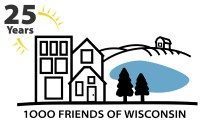The Kenosha Transportation Academy wrapped up last week with final project presentations held at Carthage College.

I’ll be honest, when I started preparation for this Academy, I wasn’t sure how it was going to unfold. Kenosha is bigger and more spread out than any other location where we’ve run this program so far. The city’s foundations in auto manufacturing contributed to its auto-centric design. Naturally, Kenosha is not a model for prioritizing active transportation infrastructure. I wondered how I would connect with anyone in the community and convince anyone to sign up.

But you know what? It turned out to be fantastic. Several members of the class serve on the Kenosha transit commission. Other participants are healthcare and disability service professionals. There was also a strong showing from Carthage College students who are embarking on careers in urban studies, environmental science, GIS, and engineering. Two staffers from the Kenosha planning department brought their expertise and insight to the group. A number of participants were there as advocates for themselves or their family members whose disabilities severely limit their transportation options because they can’t drive a car.

I know my emotions are on overdrive this week, but I’m getting a little verklempt thinking about what a privilege and an honor it has been to spend the last few months getting to know Kenosha and the people who participated in this program as participants and speakers. Everyone was thoughtful, engaged, and respectful. Everyone brought their own valuable perspective to the class. Everyone demonstrated a commitment to improving the transportation environment in Kenosha not just for themselves, but for the whole community. That’s really what the Community Transportation Academy program is all about.

Let’s get to the final projects. There were nine in total, more than any other Academy so far!
The primary concerns for participants in the Kenosha Transportation Academy centered around transit access, pedestrian safety, and street design in the Kenosha area.



Tayler Jones – Pedestrian level of traffic stress tool. Researchers at the UW Milwaukee School of Architecture and Urban Planning have developed a tool to measure pedestrian level of traffic stress. It quantifies speed limit, traffic volume, sidewalk width, and buffer width (between street and sidewalk), as well as elements of traffic control at intersections.
Will Kotomski – Pedestrian Path Expansion & Intersection Safety Improvements. There are many risks to pedestrian safety on the roads surrounding Carthage College. Simple improvements such as installing crosswalks, sidewalks, and rapid flashing beacons at key locations would improve safety for pedestrians in the campus area, many of whom are students.
Marty Hutchings – Accessible Pedestrian Signals. October is pedestrian safety month, and thus a good time to highlight places in Kenosha where audio pedestrian signals would make crossing the street much safer for people who are blind or visually impaired.
Kelly Welz – Healthcare and Transportation in Kenosha County. Lack of transit access has short and long term impacts for people who need to access healthcare in Kenosha County. There are many options, but they are limited and sometimes expensive. Expanding transit access to healthcare will lead to better outcomes in the long run.
Emily Reed – Are Guaranteed Bus Transfer Centers a Good Idea? There are many locations in Kenosha where transit routes intersect within a few minutes of each other. Designating them as mini transfer centers and guaranteeing that the bus routes overlap would improve travel time for many transit users who take more than one bus.
Christopher Lyons – Highway 50 Shopping Corridor Improvement. A retail area in Pleasant Prairie would see multiple benefits to housing access and the local economy if they consider redesigning the highway 50 corridor to be more pedestrian-friendly.
Kelly Steele and Charlotte Monroe – Intersection Improvements for Safety near 52nd and 13th. Introducing traffic calming measures and fixing street lights would improve pedestrian safety in an area with amenities that serve local businesses and Kenosha’s youth population, especially the Boys and Girls Club.
Steve Reeves –Making Sheridan Road more functional, safer, enjoyable, and inviting. Adding street trees would make Sheridan road more inviting and pleasant for all users.
Rachel Gasper – Adopting a Complete Streets Policy in the City of Kenosha. This presentation covered the history of complete streets, how they benefit communities, and what it would take to implement a complete streets policy in Kenosha.
In addition to the presenters, I owe my deep thanks to:
- Tim Casey (City of Kenosha Director of Planning and Development) for bringing the Academy to Kenosha;
- Dr. Sarah Rubinfeld (Professor of Environmental Science at Carthage College), for her willingness to offer the course at Carthage College for student credit;
- Rachel Gasper (City of Kenosha Planner), for co-planning the Academy, recruiting speakers and participants, inviting guests to in-person sessions, and getting me up to speed on projects and development activity in Kenosha. She is the Kenosha whisperer.

Susan Gaeddert is Community Programs Director at 1000 Friends of Wisconsin, where she runs Active Wisconsin, facilitates the Community Transportation Academy, and coordinates the Wisconsin Climate Table. Have you read any good books lately? Send your recommendation to: susan@1kfriends.org
